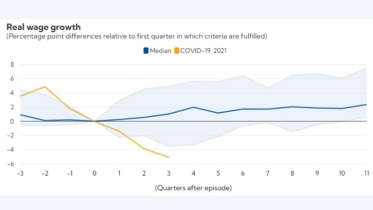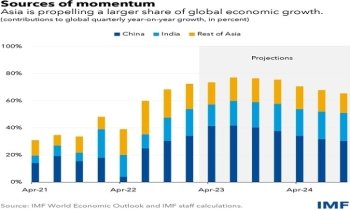Issues and agriculture sustainability in Bangladesh
Kafi Khan || BusinessInsider

Md Kafi Khan. Photo: Collected
In Bangladesh, most people working in agriculture are above 50 years of age. The new generation is not coming to the sector. In 2000, our farm labour was 80% of the population. This has now dropped to 40%. By 2030, it will drop to 27%.
The garment sector, service industry and other business ventures and migration have resulted in this. Soil temperature has risen in the last 5-6 years due to climate change resulting in declining land fertility. Besides, agricultural land is declining due to housing projects and industrialization. These could all come together to create a food crisis in the country. The impact of this state of affairs in the agricultural sector will be huge.
Basically, it needs to import or produce more to meet our food needs and that’s why it should give emphasis on feeding a growing population relying more on technology and making the sector more profitable.
Bangladesh has to import 10 million tonnes of food grains. This is because 70-80% of the land is used for paddy cultivation. The yield of paddy is four tonnes per hectare, but this can be increased to 7-8 tonnes, freeing up to 40% of the land.
The Netherlands, with the assistance of its ministry of agriculture, produces 1,000 tonnes of tomatoes per hectare of land. But in Bangladesh, it is only 25 tonnes per hectare in winter and 60 tonnes in summer. In our country, a cow gives 2-3 litres of milk whereas in New Zealand a cow gives 30-40 litres.
Bangladesh’s growth in variety and breed technology has been 130% between 2008-2020. Technological innovation in agricultural management has grown by 103%.
While both the government and the private sector have had a hand behind these growths, the participation of the private sector has been much less than seen in other countries.
With just 60 lakh cattle, New Zealand is leading the global milk market whereas Bangladesh was still the largest milk importer despite having 2.5 crore cows. Godrej of India is running a cattle farm in Pune. They get 39 litres of milk per cow daily. But in our country, we do not get more than 4-6 litres. By using this model of Godrej in our country, milk will not have to be imported.
Due to the private sector, improved seeds are coming to the country. About 90% of the seeds were supplied by the private sector. For cattle, the government is giving 30-35% support. In the case of poultry, almost 100% is being done by the private sector. For fish, more breeds were being imported by individuals than the government.
The BT Brinjal, a genetically engineered variety of eggplant, was brought to the Bangladeshi market, consumers were at first wary. But slowly, the high-yielding variety has also proved to be immensely popular.
The digital transformation of agriculture in Bangladesh:
The traditional agriculture sector in emerging markets is being transformed by digital technologies and can be viewed from the lean startup lens — “think big, act fast, start small”.
Bangladesh needs to develop a dynamic and vibrant AgriTech ecosystem in five key business models: farmers advisory, peer-to-peer lending, traceability, digital marketplaces, and mechanization.
The digital transformation of agriculture involves the adoption of digital technologies such as mobile/internet connectivity, artificial intelligence (AI), machine learning (ML), cloud computing, the Internet of Things (IoT), and blockchain/Distributed Ledger Technology (DLT).
To operationalise and take full advantage, a “digital agriculture ecosystem” must be developed.
This includes Digital infrastructure, such as agriculture data (farmer registries, soil maps, weather, agronomy, pest and disease surveillance); digital hardware (drone technology, satellite/GIS, sensors, soil diagnostic tools); and digital software (data capture tools, field agent management tools, blockchain platforms).
Also, Digital application areas, such as Advisory services: dissemination of information to improve farming techniques and promote new technology, Market linkages: facilitating sales between farmers and buyers, Financial access: provision of finance to increase farm productivity or profitability, Supply chain management: tracking and managing supply chains to improve profitability through certification and traceability, Macro agri-intelligence: generating and/or disseminating macro data to stakeholders.
To develop the digital agriculture ecosystem, three critical factors are needed: data, innovation, and partnerships between multiple stakeholders in the public and private sectors.
Digitally transforming the agriculture sector:
Building strategic partnerships with private businesses, in the form of an “Innovation Hub”, can use data to unlock the full potential of technology-enabled transformation in agriculture.
There are four key characteristics of an Innovation Hub that would be essential to offer a positive environment for the development and growth of AgriTech startups.
Cross-sector development: The linkage from AgriTech to FinTech platform by developing financing products that are well-suited for farmers’ production cycle and by connecting AgriTech with commercial banks for additional sources of funding for lending to farmers.
Importance of strategic partnerships: AgriTech startups have expanded the network of farmers by engaging with new agribusiness partners such as government and business-to-business (B2B) relationships to work directly with farmers.
Building resilience to address risk and challenges: Strengthening the firm’s risk management platform while helping smallholder farmers such as the contactless transaction and the use of technology such as using IoT sensors to measure crop yields.
Capacity building and innovation: Introducing climate-smart agriculture to smallholder farmers to encourage sustainable agricultural practices in growing more food at lower cost through innovative practices that produce higher quality crops, and addressing high-cost items such as efficient use of fertilisers and irrigation for the types of soil.
Together with enabling regulations and increased investments in infrastructure, digital technologies will be the key enabler to address food security, reduction in food wastage, sustainable farming, and climate crisis.
The establishment of the Innovation Hub in Bangladesh may bring together multiple stakeholders in the agriculture value chain to share data, foster innovation, provide investment, mentoring, and capacity building for young startups.
More technological innovation in agriculture is needed today. This is a global challenge and the time to act is now. In the spirit of the lean startup mindset: Let’s think big, start small and act fast.
The author is company secretary, The City Bank Limited
























